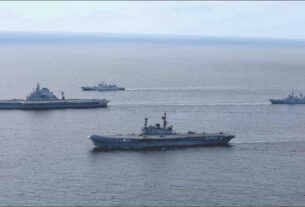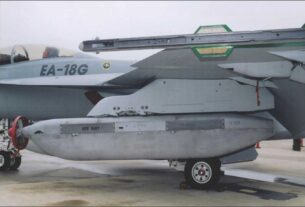India is set to upgrade its indigenous airborne early warning and control systems (AEW&C) aircraft to the larger airborne warning and command system (AWACS) based on a western platform. Hitherto it has used the Russian Ilyushin-76 to fit an Israeli Phalcon radar and the smaller Brazilian Embraer-145 on which it attached an airborne radar system designed and developed in Indian laboratories.
While these two systems complement each other, a larger-bodied platform indigenously constructed is a long term requirement. The French Airbus company has offered is A-330 aircraft to be converted into a radome-carrying package. It remains to be seen how the NDA government handles this “single vendor” proposition which was hitherto taboo.
India has been working on airborne radar systems for the past quarter century. It began an indigenous project based on the HS-748 Avro transport aircraft but abandoned it when the lone testbed crashed while testing an imported radome (radar dome). To save time and yet acquire state-of-the-art technology it turned to Israel to marry its Phalcon radar with an Il-76 transport aircraft having substantial experience of flying which had been acquired over many years. Three were acquired initially with a follow-on order of three more.
Given the size of the Indian landmass and the contiguous seas abutting peninsular India six plus six does not appear to be sufficient to ensure a 24×7 airtight surveillance. The presence of the maritime strike aircraft Poseidon P-8I fulfils a naval requirement but its radar does not have the kind of coverage required for long range track-while-scan that has become imperative in a dense air defence scenario.
Technical upgradation
Simultaneously, India negotiated with Brazil to use its Embraer-145 as a testbed to fly an indigenously-developed pencil-shaped (instead of dome-shaped) externally-mounted radar. The first three were also followed up by an additional three. While searching for a bigger platform, India has indicated that it would require a minimum of ten aircraft. This is intended to take care of the technical upgradation that would need to be incorporated in the first lot of Israel-acquired AWACS given the time-lapse between the acquisition of the two systems. The older AWACS would be given a mid-life modernization that would keep it relevant for another decade or so.
It must be stated very categorically that the Indian airborne early warning and control system suite of sensors is acquiring maturity by the day and more of it is being installed in the aircraft that are being manufactured/assembled in India. Even with the conversion of the first Il-76 into an AWACS several gadgets designed and developed in laboratories in India under the Defence Research and Development Organisation were installed. They included the Identification Friend or Foe (IFF) and the data-links that would deliver the information gathered by the onboard sensors to the airborne air defence aircraft, ground stations and anti-aircraft batteries as part of the network centric warfare arrangement.
In the case of the Embraer-145 among the first Indian components-the Active Array Antenna Unit (AAAU), developed by DRDO’s Centre for Airborne Systems (CABS) at Bangalore-was installed. The device consisting of two radiating planar arrays assembled back-to-back and mounted on top of the fuselage in an active antenna array unit (AAAU) makes for a 240° coverage. The first modified fuselage platform which was handed over to DRDO by Embraer included as many as one thousand components required for the Mission System. Among these was the Active Electronic Scanning Antenna (AESA) radar developed by DRDO. Some of the sensitive advanced systems were replaced with dummy equipment of equivalent size and weight. These were to be integrated into the fuselage at a later date on arrival in India.
The Embraer has a seating capacity for five crew at work stations and airborne refueling probe enables the aircraft to extend its endurance by as much as nine hours in an emergency.
The incremental growth of expertise within the Indian defence establishment in putting together as complicated an airborne platform as the AWACS/AEW&C has rendered it amenable to better maintenance and has reduced costs given that systems form a large part of the costing.
System integration
The next generation of indigenous AWACS to be built around the Airbus A-330 will test the capabilities of the Indian entities at every step from creation of state-of-the-art systems in long-range sensors to systems integration of the final product. This will be the responsibility of the National Aerospace Laboratory for the flight modeling of the fuselage; the Electronics and Radar Development Establishment (LRDE) for the primary radar; the Defence Electronic Applications Laboratory at Dehradun for the communications system and the data link; the Defence Avionics Research Establishment, Bangalore for the self-protection and electronic warfare suites; Defence Electronics Research Laboratory, Hyderabad, for the self-protection system (that will include the pyrotechnic gadgetry to draw heat-seeking missiles away from the main aircraft) and electronic counter-measures equipment.
The overall program management will rest with the Centre for Air Borne Studies along with the integration of every system and subsystem into the whole package. A great deal of systems and subsystems will be farmed out to the growing number of Indian private sector industries that are taking a greater interest in defence equipment manufacturing in conjunction with foreign arms companies with which they have forged joint ventures.
It is well known that in order to close the many gaps in the air defence ground environment system (ADGES) India had to resort to the acquisition of the proven Israeli long-range radar for its Il-76 aircraft. Given the vast Indian landmass it is obvious that a large number of AWACS/
AEW&C will be required to ensure a failsafe ADGES.
For greater situational awareness, India has been inducting more and more unmanned aerial vehicles and tethered aerostats for localized use. Nonetheless, given the recent Gurdaspur terror strike Pakistan always manages to catch India napping. Such kinds of terror strikes could inevitably lead to a more wider confrontation. Under such circumstances the role of the AWACS will become paramount and India would need them in sufficiently large numbers to be able to deal with the situation.
It needs to be remembered that as in every new military development in terms of arms and weaponry there comes a time when counter-measures are developed to negate their efficacy. Much the same has happened in the case of the AWACS. This is seen in the long-range missiles that the Russians and Chinese have developed to specifically destroy the AWACS even while it is flying well within its own territory and at a reasonable height. That is why even as new self-defence suites are developed there is need to incorporate within the system long-range threat evaluation by electronic means. After all it is a truism that for every new weapon a counter-measure will eventually be found.




